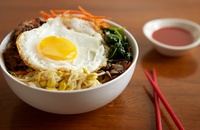
If you think authentic Chinese food is limited to what arrives at your door in tiny white boxes, think again. China is big—about the size of the US but with nearly four times the population—and the dishes across its 22 provinces are far more varied than what you'd find at your typical Chinese takeout restaurant. Regional fish dishes in Shanghai and Hong Kong, for example, are just as distinct as New England clam chowder and New Orleans seafood gumbo.
So how do you find the best Chinese dishes in the States? You have to do two things, according to Kian Lam Kho, the New York–based creator of the Red Cook blog and the author of the cookbook Phoenix Claws and Jade Trees: Essential Techniques of Authentic Chinese Cooking.
First, "go to restaurants in neighborhoods with [a high] concentration of newly arrived immigrants," Kian told us in an interview. Second, go beyond sweet-and-sour chicken. "Most Americans are very familiar with stir-fried dishes," Kian explains, "but Chinese cooking encompasses a great many cooking techniques, including braising, steaming, boiling, [and] soup making." For Kian, emulating these techniques is just as important as sourcing the right ingredients for any given dish.
Kian also says that America might not be ready for a few Chinese delicacies, specifically, the ones made with silkworm and cicada chrysalises, bee larvae, and other insects. But while we catch up with the rest of the world in terms of bug consumption, here are five of the best Chinese dishes to seek out and the regions they hail from.
Peking Duck (Beijing)
Beijing cuisine favors elaborate presentations that were worthy of the Imperial Court.

At Sun Wah BBQ in Chicago, Peking duck is a three-part feast that does justice to its imperial past. The duck itself is seasoned, slow-roasted, and hand-carved at tables, where diners enjoy the crispy skin with steamed bao, pickled daikon radish, and garnishes. The bones and remaining meat are then taken back to the kitchen to create a savory broth and duck fried rice. One of our writers loved the duck feast so much that he said he would "order it again in a heartbeat."
Buddha Jumps Over the Wall (Fujian)
Fujian cuisine is known for blending ingredients from the mountain and sea.

It takes three days to prepare, and it can incorporate more than 30 ingredients, so it's no wonder that Buddha Jumps Over the Wall most commonly appears at lavish banquets. (It's also a favorite of Kian.) This steamed soupy dish, which features sea cucumbers, quail eggs, pork, chicken, duck, and other components, is thought to have originated during the Qing dynasty. As for the name, rumor has it that the soup's smell was so tantalizing, it caused a Buddhist monk to jump over a monastery wall to try it.
This dish is not without controversy, however; traditional versions prepare it with shark's fin, which raises international concern over the sustainability and welfare of sharks. Should you like to try a bowl, leave the shark's fin out—you won't compromise the soup's taste.
Beggar's Chicken (Jiangsu)
Jiangsu cuisine features fresh flavors and textures that are soft, yet never mushy.

According to this dish's legend, a beggar happened upon a wild chicken and wanted to cook it in secrecy, so he put it atop hot coals and covered it in mud to seal in its smell. Despite his efforts, it was still noticed by a traveling nobleman, who sampled the succulent chicken and excitedly took the recipe to the Imperial Palace.
Whether or not this legend is true, the technique works: trapping in the chicken's natural juices leads to an incredibly moist dish. Modern chefs don't keep mud in the kitchen, though. It's more common to wrap the chicken in lotus leaves and seal it in either clay or flour-based dough.
Xiao Long Bao (Shanghai)
Shanghai cuisine is big on rich sauces and full-bodied flavors.

Though they're referred to as dumplings, xiao long bao are actually steamed buns that are traditionally filled with pork and a steamy broth. Because broth is hard to package in its liquid form, this particular broth starts out as a gelatinous substance known as aspic, which can be wrapped up and then heated until it liquefies within the dumpling.
Don't make the mistake of trying to eat the dumpling in one hot, tongue-scalding bite; rather, savor the experience by puncturing it first and enjoying the contents in tasty increments.
"Numb and Spicy" Hot Pot (Sichuan)
Sichuan cuisine is characterized by bold, spicy flavors, with a heat that creeps up on you.

This dish is composed of a simmering broth, vegetables, spicy ingredients such as chili, and thin slices of meat that begin to cook as soon as you plop them in the bowl. It also contains Sichuan pepper, which actually numbs your tongue so you can handle even more spice than you thought humanly possible.
When our editor's husband visited the Sichuan region, trying the "numb and spicy" hot pot was a must. His meal unfolded in a restaurant where the tables acted as bubbling cauldrons, and where nearby patrons nonchalantly popped whole peppers into their mouths. Meanwhile, said husband nearly slid out of his chair from the amount of sweat dripping down his face. Yet he still maintains that the meal itself was delicious.

Peking duck images by Andrew Nawrocki, Groupon. Sichuan Hot Pot by Matt Ryall under CC BY 2.0
RELATED READS:






